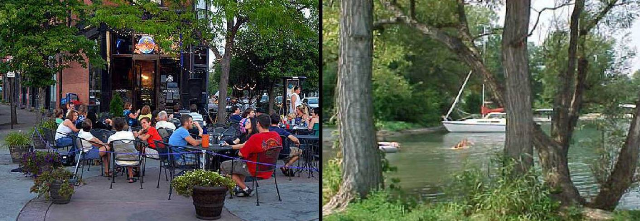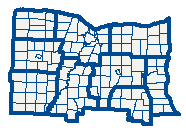
Located in western-central New York State, the nearly 4,700 square-mile Genesee-Finger Lakes Region stretches south from the shores of Lake Ontario to the low rolling hills of the Appalachian Highlands. Many striking natural features and scenic vistas lie within the nine-county region including the western Finger Lakes, the Genesee River, and Letchworth State Park, commonly known as the Grand Canyon of the East.
Founded in 1803 and incorporated in 1834, Rochester is New York State's third largest city (2010 population: 210,565) and the internationally recognized corporate and cultural center of the region that includes the counties of Genesee, Livingston, Monroe, Ontario, Orleans, Seneca, Wayne, Wyoming, and Yates. The region is home to approximately 1.2 million residents and more than 27,000 businesses with over one-half million employees.
Industry & Agriculture
The region is known throughout the world as a leader in the development and production of optics and imaging products and technologies. The region's preeminence in these industries began in the late 19th century with the founding of Eastman Kodak and Bausch & Lomb in Rochester and has expanded significantly as other firms throughout the region have made advances in optics and imaging (photonics) technologies and integrated them into other sectors, including biotechnology and telecommunications.
In addition to optics and imaging, the region is a major manufacturer of precision instruments, fabricated metals, and transportation equipment. More persons are employed by manufacturing and related support service firms in this region than in any other in New York State.
Agriculture is also an important component of the regional economy with the production of fruits, vegetables, dairy products (both for export and in support of the expanding food processing sector), and world-class wineries.
Given the region's production of high-quality goods and its close proximity to major population centers in the United States and Canada, it is not surprising that the region is a major exporter both domestically and internationally. In terms of value, the Gross Domestic Product of the Rochester Metropolitan Area (Livingston, Monroe, Ontario, Orleans, and Wayne counties) was the 54th largest of the nearly 370 metropolitan areas in the United States in 2009 at more than $45 billion (Yates County has since been added to the Metropolitan Area), demonstrating that the regional economy is an important contributor to the national economy.
Education
With over 80,000 full- and part-time students, the more than 20 two- and four-year universities and colleges in the region are essential in training the future workforce, upgrading the skills of employees and those seeking work, and acting as an economic catalyst employing over 5,500 persons. Furthermore, these institutions play a vital role alongside local industry in creating an environment of innovation that is unequaled in the nation as measured by the number of patents issued per worker.
Culture
Cultural and historical attractions abound throughout the region. The City of Rochester plays host to museums of science and art, theatrical productions, the Strong Museum, Rochester Philharmonic Orchestra, the George Eastman House and its International Museum of Photography and Film, and several festivals. From an historical standpoint, the region is renowned as the birthplace of the women's suffrage movement, center of the abolitionist movement, and for its American Indian heritage. This renowned past is preserved and celebrated in numerous venues including the Women's Rights National Historic Park, the Susan B. Anthony house, and the Ganondagan State Historical Site.
Climate
The average daily temperature of the region varies from 24 degrees Fahrenheit in January to 71 degrees Fahrenheit in July, providing recreation opportunities that range from downhill skiing at numerous locations during the winter to water sports and fishing in the summer. In addition, the region's local and state parks offer year-round opportunities to enjoy a range of outdoor activities and the changing of the seasons.
Charity
An integral part of the region's character is its spirit of philanthropy. The legacy of giving that was established by George Eastman and other early civic leaders continues through the charitable foundations that they and their counterparts throughout the region's history have created. More significant than the largess of the more notable benefactors is the level of giving by residents of more modest incomes, as evidenced by Rochester and Monroe County currently leading the nation in per capita charitable contributions.
Transportation's Role
While topography and natural features shaped the earliest physical development of the region, it was the opening of the Erie Canal in 1825 that laid the foundation for the Genesee-Finger Lakes Region's prosperous future. The presence of such an efficient transportation route to America's frontier enabled entrepreneurial skills and talents to be combined with the natural resources necessary to fill a burgeoning nation's demand for goods and provisions. Even though the Erie Canal eventually gave way to railroads and then highways as the primary modes of travel, it remains a prime example of the impacts that the transportation system can have on the character and development of a region. Regardless of the form it takes in the future, the ability of the transportation system to safely and efficiently move people and goods will continue to be a major factor in determining the quality of life and economic success of the region.
REGENERATION: Improving connections to address key issues in the Genesee-Finger Lakes Region (2011 Regional Assessment Report)
